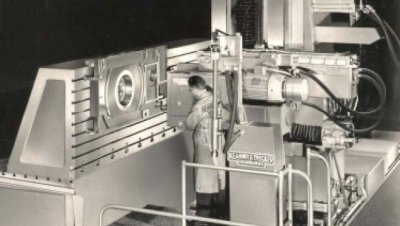John T. Parsons History Project
Traverse City is historically rich in manufacturing and in the aerospace Industry. One example includes the famous inventors John T. Parsons and Frank Stulen who are memorialized at a Northwestern Michigan College building on Aero Park Drive. Parsons and Stulen pioneered numerical control (N/C) for machine tools in 1945 while manufacturing helicopter rotor blades. They were also among the first to use computer methods to solve machining problems. The systems they developed—marketed as the Digitron and the Cardamatic—and the control of the machines to make the complex structures gave birth to Computer Numerical Controlled (CNC) Machining. In all, Parsons was awarded approximately 50 patents.
Parsons Corporation of Traverse City produced and overhauled helicopter rotor blades for all the major helicopter manufacturers from the 1940s through the ‘60s. Parsons also pioneered adhesive bonding in metal aircraft structures and then built the first all-composite airplane. Parsons produced the 44 ft. long stainless steel fuel lines for the Saturn V booster that started the U.S. astronauts toward the moon and he brought computers to aircraft design, manufacturing, and real-time management reporting. The Parsons legacy even includes manufacturing Lake ‘n Sea fishing boats in the late ‘50s and early ‘60s.
This story needs to be told and published so that our community can take advantage of the legacy that Parsons created in Traverse City. The proposal at hand is to dive into the history of John T. Parsons and the Parsons Corp. to create a short book that tells this story in an accurate and informative way.
For additional information on the John T. Parsons Project, please visit: The John T. Parsons Project and Traverse City Industrial History.

Beaver Island
Before Michigan Tech set up operations in the Grand Traverse Area, the Alternative Energy Enterprise (AEE) and Michigan Tech’s Social Science (SS) Department have been working with Beaver Island which is located approximately 20 miles off the cost of Charlevoix, Michigan. The remote location makes island residents passionate about energy independence and sustainability. Many residents already have solar installed on their homes. The island’s main supply of energy comes from the mainland by underwater cables that are owned and operated by Great Lakes Energy (GLE). The islanders have become increasingly interested in a community solar project, where they would be able to produce energy locally.
The enterprise team conducted an initial technical analysis on the feasibility of solar energy production on the island. This analysis involves site assessments and visits, production modeling to determine system size, detailed engineering design of the solar array components, and a preliminary economic analysis. There are two locations that the team is considering for community solar: the former Beaver Island landfill site and trust land located near the landfill. These locations provide ample room for solar arrays and have a potential for battery storage systems in the future.
In June 2022, the U.S. Department of Energy announced 12 competitively selected remote and island communities for the second Energy Transitions Initiative Partnership Project (ETIPP) cohort. ETIPP connects remote and island communities with regional organizations and national laboratories to develop strategies to improve their energy resilience, or the ability to anticipate and adapt to changing conditions and recover rapidly from energy disruptions. Projects in selected communities focus on efforts to reduce reliance on fossil fuels, increase energy efficiency and resilience, and optimize renewable resources and battery or storage technologies. Beaver Island was among the 12 communities selected. Energy resilience is a particularly complex and costly challenge for remote and island communities. Many of these communities face risks associated with natural disasters and climate change impacts, on top of high energy costs, vulnerable fuel supply chains, and unreliable energy infrastructure prone to outages or damage. ETIPP provides technical assistance—in the form of strategic energy analysis and planning—for communities to make informed decisions regarding their energy transition choices. ETIPP’s community-driven approach keeps communities involved in the decision-making process, with regional organizations providing contextual knowledge of local culture and challenges to national lab experts, who use these insights to help identify the technical solutions that best meet community needs.
The Beaver Island Community is well on their way to reaching their goals to create more renewable and sustainable energy solutions for their remote Island.
Interlochen
The Interlochen Center for the Arts is located in Interlochen, Michigan and is a private high school centered around education in the arts. The Center is home to many students around the world that come to learn. The Center is well known locally for the music and shows that are put on to provide culture and entertainment.
With all the positivity the Center contributes to their community, they are looking
for more ways to be leaders in sustainability efforts. Since the Center uses a significant
amount of energy through housing, putting on shows, and lighting buildings, they have
started looking at alternative energy production as a
means to offset their current energy use and carbon footprint. The Director of Sustainability
and Instructor of Agricultural Sciences at Interlochen contacted the Michigan Tech
Traverse City Research Center (MTTCRC) with the idea of solar generation on the Interlochen
property or buildings. Michigan Tech
has experience with advising companies, residents, and communities on solar installations
through their research and teaching the Alternative Energy Enterprise (AEE) Class
at Michigan Tech in Houghton.
An AEE student met with Interlochen and suggested this become a team project for them in the Fall of 2021. Various studies were conducted and recommendations were provided to Interlochen.